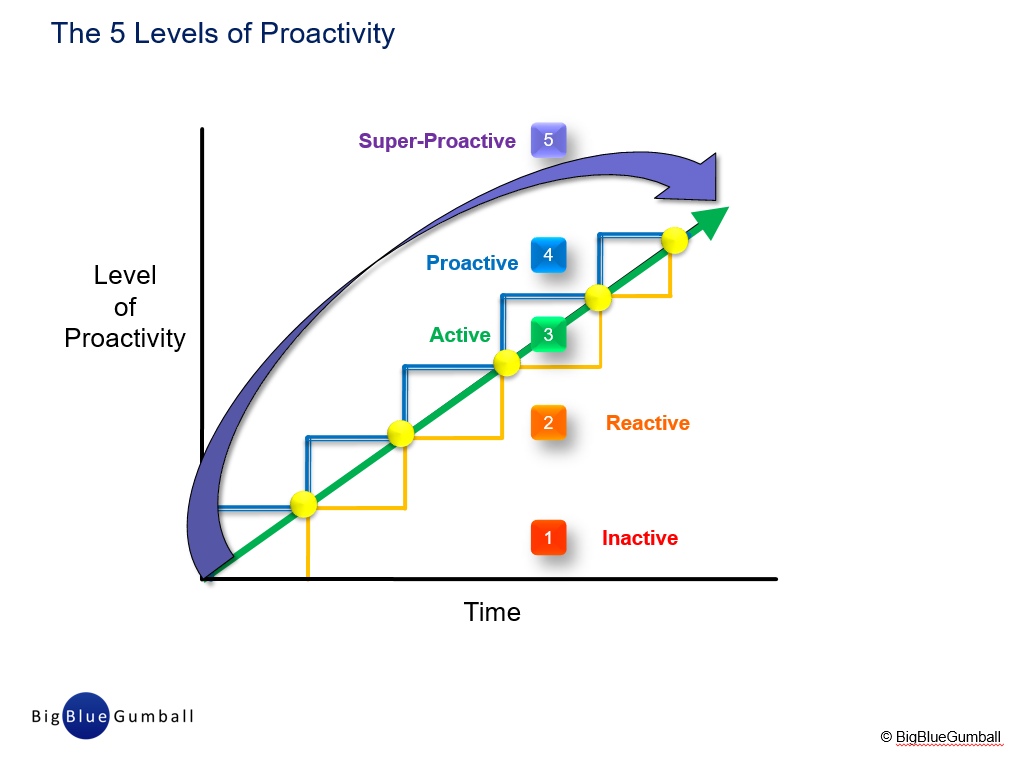 Todd Cherches | Comments Off |
Todd Cherches | Comments Off |  Careers,
Careers,  Management,
Management,  leadership,
leadership,  levels,
levels,  proactivity,
proactivity,  success
success  Wednesday, November 16, 2016 at 6:32PM
Wednesday, November 16, 2016 at 6:32PM 
Do you wait for things to happen . . . or do you make them happen?
Do you find yourself stalling for the perfect time to take action…or do you make “now” the right time?
Do you always find yourself one or more steps behind and playing catch-up…or do you go about your business feeling confidently and comfortably ahead of the curve?
Whether we’re talking about your personal life or your career, one of the most overlooked keys to success is the level of “proactivity” at which you tend to operate.
Life and work are filled with daily barriers, obstacles, and challenges that stand in the way of our getting things done. For example:
There are probably other factors as well. But if you look at this particular list, what all these reasons have in common is that they are all INTERNAL…and, therefore, all within our control.
HOW PROACTIVE ARE YOU?
Here is a simple-yet-powerful model that we call “The 5 Levels of Proactivity.” Let’s explore it from the bottom up to see how we can work our way up from being Inactive, to Reactive, to Active, to Proactive, and, ultimately, to Super-Proactive:
Level 1: INACTIVE. At this level, something is needed from you…and you do nothing. Absolutely nada. Zero. Zilch. For whatever reason, you decide to take no action at all. Maybe the problem or request will just go away by itself. But probably not.
Level 2: REACTIVE. At this level, something is needed, and you respond. This is actually a good thing! So congratulations – you’ve put out the fire. The only problem is if you are constantly in reactive, fire-fighting mode, you are always at least a step behind. After a while, as the speed of needs and expectations increases, you may fall so far behind that you are unable to catch up. And then people are constantly waiting for you, getting frustrated and impatient…until they decide to look elsewhere for what they need.
Level 3: ACTIVE. When you are at this level, you are keeping up with demand, giving people what they want and need, in real-time, when they need it, and meeting expectations. Things are going well, and you are keeping up with the pace. The only problem is that when you are just keeping pace, you are not getting ahead. At this level, there is no time or space for growth. You’re getting things done, but you’re either treading water or standing still. And in an ever-changing world, if you’re standing still, you’re falling behind.
Level 4: PROACTIVE. Now we’re getting somewhere! At this level you are not only keeping up with the pace, but setting the pace and staying a step ahead. You are not just putting out fires, you’re preventing them. You are not just meeting expectations, you’re exceeding them. Anticipating others’ needs and expectations, you are thinking on your feet, doing your homework, looking down the road, putting yourself in the shoes of your customers, fostering an environment of growth and development for yourself and others, and taking control of your destiny. Remember that the root word of “pro-act-ivity” is “act” – and you are ready, willing, and able (and excited) to ACT!
Level 5: SUPER-PROACTIVE. Now you are not just setting the pace…you are leading! With a vision of the future, you are thinking not just one step ahead, but many steps ahead. This is where innovation happens, this is where paradigms shift, this is how you drive change and blow people away. This is where you develop your reputation as a guru of, or the go-to person for, things. The leaders of the future are those who are able to meet the demands of today while consistently anticipating and exceeding the needs of tomorrow. You anticipate what people want and need before they even realize it. You are a visionary. And as management guru Peter Drucker famously said, “The best way to predict the future is to create it.”
That’s the model in a nutshell. Now let’s bring it to life with a simple, practical, real-life example: Let’s say it’s January 1st and you decide you want to get in shape for the summer.
If you’re INACTIVE, you don’t do anything about it. You procrastinate, you say, “It’s only January. I can wait a few months to get started.” But didn’t you just “decide” you were going to take action? That reminds me of the old riddle: There are five frogs sitting on a log, and one decides to jump in the water. How many frogs are now sitting on the log? The answer: Still five. One “decided” to jump in, but he didn’t actually DO it. It’s not the “deciding,” but the “doing” that counts.
If you’re REACTIVE, you’ll work out if someone else drags you along to the gym, or you’ll eat better if someone else shops for healthier food and places it in front of you. But you are not in control, and you are not taking responsibility, driving the changes, or owning the behavior necessary to achieve your desired outcome.
If you’re ACTIVE, you’ll get off the couch and work out if the mood hits you, and you’ll have an occasional low-calorie fruit juice or water rather than a soda. And you’ll replace that Big Mac with a salad. Your intentions are good, you’re taking baby steps, and you’re trying, but it’s sporadic and undisciplined, and you don’t really have a plan.
When you’re PROACTIVE, you make a plan – a structured, formalized, written plan, and you stick to it. You put a process in place and set a quantifiable goal of working out x days a week – no excuses. Your diet plan includes the sacrifices you’re willing to make...and you keep those commitments without fail. You follow through and you follow up. You make real behavior changes and track the results, with no excuses and no exceptions.
And what would being SUPER-PROACTIVE look like? It’s about having a longer-term time horizon and thinking many steps ahead. It’s about imagining the possibilities and anticipating potential obstacles that may arise down the road. Perhaps thinking and planning beyond the summer, into the fall, winter, spring, and maybe even into following year. Always thinking and acting with the big picture and a long-term vision of the future in mind.
So that’s just one example. How might YOU use this model to be more proactive in your personal life? To be less stressed? More productive? Happier? To take charge of your career? To get more things done? To impress your boss, to better serve your (internal and external) customers, or to be a more effective manager and leader?
How important is proactivity? In Stephen Covey’s classic book The 7 Habits of Highly Effective People, “Be Proactive” is Habit #1. That’s how important it is.
It’s not easy being proactive; it takes time, attention, energy, discipline, and vision. But the good news is that the decision to be more proactive is entirely up to you and completely within your control. And it’s never too late to get started. As Confucius said, “The best time to plant a tree was twenty years ago; the next best time is today.”
And while being more proactive – and super-proactive – may involve making some radical changes and taking some substantial risks, as the saying goes: sometimes we just have to go out on a limb…because that’s where the fruit is.

 Todd Cherches | Comments Off |
Todd Cherches | Comments Off |  Careers,
Careers,  Management,
Management,  leadership,
leadership,  levels,
levels,  proactivity,
proactivity,  success
success  Saturday, March 5, 2016 at 3:53PM
Saturday, March 5, 2016 at 3:53PM 
There’s a classic riddle that I use in my leadership workshops that goes like this:
There are 5 frogs on a log.
One decides to jump into the pond.
How many are left on the log?
The answer: Still 5.
Why?
Because he DECIDED to jump in…but he didn’t actually DO it!
And it’s the DOING that counts.
When I was ten year’s old my family went to a local town pool club that had a high diving board. All the other kids were having so much fun scampering up that tall ladder and jumping into the water that, after much deliberation, I hesitantly decided to give it a try too, even though I had a debilitating fear of heights...and of other kids.
So I gingerly climbed the ladder and inched my way out to the edge of the diving board. But then I looked down…and it was even more terrifying than I was expecting it to be!
So I quickly changed my mind and turned around with the intent of going back down the ladder…only to find that about five other kids had already climbed up the ladder impatiently waiting their turn.
“COME ON…GO ALREADY!!!” they were all screaming at me. So, completely embarrassed, and with, really, no other choice, I turned back around again, ran the length of the board, and dove in – head first!
What do you think I did the rest of that summer afternoon? Yup. I kept on climbing that ladder and diving back in again and again and again until the sun went down and it was time to go home.
Writing this, I am reminded of one of my all-time favorite Seth Godin posts, and probably his shortest. It simply said: “You don’t need more time. You just need to decide.”
And after deciding, we actually need to act.
So often we are racked with indecision and/or paralyzed by fear that we put off making any decision, until the window of opportunity closes, and the decision is made for us.
In fact, if you think about it, NOT making a decision is a decision you've made.
And how many potentially positive, life-enhancing decisions might we have missed out on simply due to our own procrastination? We come up with excuse after excuse about why something can’t be done, but as futurist Joel Barker reminds us -- and as I experienced on that high diving board many years ago -- “Those who say ‘it can’t be done’ need to get out of the way of those who are doing it.”
The bottom line is that no one wants to Hear excuses; they only want to See results.
The psychologist William James famously wrote that “There is no more miserable human being than one in whom nothing is habitual but indecision.”
So on this Leap Day, think about what big decisions you need to make, make them…and proactively take the leap. My bet is that, in the long run, you’ll look back and be glad you did.
Or you can simply decide to just wait until next Leap Day.
After all, it's just four more years away.
 Todd Cherches | Comments Off |
Todd Cherches | Comments Off |  Decision Making,
Decision Making,  leadership,
leadership,  proactivity
proactivity  Friday, June 20, 2014 at 5:43PM
Friday, June 20, 2014 at 5:43PM "In an ever-changing world, if you're standing still...you're falling behind."
~Todd Cherches
 Todd Cherches | Comments Off |
Todd Cherches | Comments Off |  Inspiration,
Inspiration,  change,
change,  motivation,
motivation,  proactivity in
proactivity in  Inspiration
Inspiration  Wednesday, September 11, 2013 at 1:51AM
Wednesday, September 11, 2013 at 1:51AM 
PART 1: How I Risked Everything to Pursue My Dream Job
I always wanted to work in television.
It was my dream job from the age of about 13. I didn’t want to be an actor, producer, or writer. I wanted to be one of those cool, rich guys in suits at the TV networks who come up with ideas for shows and get to decide what makes it on the air. And I was obsessed with the idea of working at my favorite network: NBC. I thought, “How cool would it be to go to work every day at 30 Rock?”
When I was in college, I‘d been a summer intern for NBC News (I still have the NBC peacock towel that Willard Scott gave all the interns at orientation). So after finishing my master’s degree in communications from SUNY Albany and then working for a year in media buying for Ogilvy & Mather advertising, I realized that if I was really serious about a career in television, I needed to move to the west coast where most of the jobs were. I had already been rejected for full-time positions by NBC, along with every other network, cable station, and production company in New York City. Even though it was the toughest decision I ever had to make, I quit my job at Ogilvy and just blurted out to my parents: “I’m goin’ to Hollywood!”
A few weeks later, with two suitcases, a couple of hundred dollars to my name, no job, no leads, and no contacts in Los Angeles, my parents dropped me off at JFK. After a teary farewell, I boarded my flight to LAX, suddenly unsure of whether or not I was making the right decision.
With reality starting to sink in, my heart pounding with anxiety, and my head spinning with self-doubt and second thoughts, I made my way up the aisle toward my seat (coach, of course) all the way in the back of the plane. As I struggled to get by, a white-haired gentleman was blocking the aisle in first class. When he finally turned around and settled into his seat, I froze: it was Grant Tinker – the president of NBC.
Three hours into the flight, I was still debating whether or not to go up and talk to him. If I did, would I regret bothering him? If I didn’t, would I kick myself for eternity? Should I casually stroll by his seat, pretending to stretch my legs, and then “accidentally” drop one of my resumes onto his lap? Would he then be so impressed that he’d offer me a job on the spot? Or would he forever ban me from NBC for having the audacity to be such an idiot? Three times I got up and peeked through the first class curtain, only to chicken out and scurry back to my seat.
With less than an hour left in the flight, I decided it was now or never, do or die. Somehow, I summoned up the courage and, almost unconsciously, made my move: I marched down the aisle, straight through the curtain, stopped at his row, turned towards him and, in one long, rambling, run-on sentence, started spouting out the words that I had been rehearsing and revising in my head for the past four hours:
“Excuse me, Mr. Tinker. I hate to bother you. I was an intern at NBC in New York last summer, and the reason I’m on this flight is because I’m moving out to L.A. to try to get a job in the TV industry, hopefully at NBC. It’s my dream job. Again, I’m sorry to bother you, but I was wondering if you might have just a minute to give me some advice or suggestions, or anything that would point me in the right direction once I get out there.”
That’s how Grant Tinker, one of the most powerful men in Hollywood, found himself looking up at a 24 year-old kid who’d just barged into first class and asked for advice. What happened next changed me — and my career — forever.
What’s it going to be? The thrill of victory or the agony of defeat? Find out in the exciting conclusion!

PART 2: I Landed My Dream Job. Then Reality Set In.
When we last saw our hero, he had just asked Grant Tinker, then-president of NBC, for advice on landing his dream job. For more, read Part 1 of Todd’s story, How I Risked Everything to Pursue My Dream Job.
“Excuse me, Mr. Tinker. I hate to bother you. I was an intern at NBC in New York last summer, and the reason I’m on this flight is because I’m moving out to L.A. to try to get a job in the TV industry, hopefully at NBC. It’s my dream job. Again, I’m sorry to bother you, but I was wondering if you might have just a minute to give me some advice or suggestions, or anything that would point me in the right direction once I get out there.”
Yes, that’s how I introduced myself to Grant Tinker, the head of NBC. I walked into first class and asked, point blank, if he could give me a few pointers for getting started in the TV industry. When I finished, there was a pause that seemed to go on for eons (OK, it was probably only a second or two). Then the president of my favorite network smiled, slid over to the window seat, extended his hand, and said, “Sure, sit down for a minute. What’s your name?”
So, there I was: 24 years old, unemployed, with nothing in the world but a dream and two suitcases, sitting in first class on my way to L.A., chatting with the head of NBC.
I’ll spare you the details of the actual conversation, but the bottom line is this: the president of what was then the number one television network in the country was generous enough to take five minutes of his valuable time to share the wisdom of his experience with a young, aspiring job seeker.
I never ended up working at NBC, but I left that conversation on an emotional high, beaming with hope and optimism, and confident that I had made the right decision. And although I am 99.9 percent sure that Mr. Tinker doesn’t recall that brief interaction of so many years ago, his words and generosity still resonate with me today.
As for my career, it took a while — with a lot of ups and downs — to finally get on track. I took a number of “survival jobs” to pay the bills, including doing telephone sales for the L.A. Times during the day (pure, monotonous torture and hours of rejection), followed by my evening job as a bouncer at a Burbank nightclub (don’t ask).
But after months of perseverance, I finally caught a break.
There was a brief internship at Aaron Spelling Productions, followed by a stint in casting administration at Columbia Pictures Television, and then a job as assistant to a writer/producer at Disney Television. Then, at last, I landed my crowning position as assistant to the manager of drama program development at CBS. I was 25 years old, and I had finally made it into a TV network.
Unfortunately, working for an abusive psycho-boss at CBS forced me to leave the industry that I loved (or, more accurately, that I thought I was going to love), never to return. After a few exciting years as a project manager in the theme park business, I ultimately moved back to New York and got into the management training field, which is what I do today.
It might seem like working in television and my current career as a management, leadership, and presentation skills consultant, trainer, and coach have nothing in common. But that couldn’t be further from the truth.
My experience in the entertainment industry taught me so much: storytelling (a crucial skill for successful leaders!); the power of visual thinking and visual communication; the effective use of metaphor and analogy; innovation and creativity; teamwork and collaboration; how to design a presentation and pitch an idea that motivates, inspires, and influences others; and so much more.
And, from my years in Hollywood, I learned numerous other life lessons that I regularly draw on as a leadership trainer, coach, and adjunct professor at NYU:
Do I miss the glamor and excitement of working in the entertainment industry? Well, I got to go to numerous TV show tapings and wrap parties. I got to sit on Seinfeld’s couch and on Norm’s bar stool on the Cheers set. I got to meet Lucille Ball, Tom Hanks, and Arnold Schwarzenegger. I had lunch with Vanna White, rode up in an elevator, alone, with Vanessa Williams, and, most memorable (and surreal) of all, I spent a half hour being interviewed, one-on-one, by Pee Wee Herman to be his personal assistant.
So, do I miss it? Maybe just a little.
 Todd Cherches | Comments Off |
Todd Cherches | Comments Off |  Careers,
Careers,  Job Hunting,
Job Hunting,  proactivity,
proactivity,  risk-taking in
risk-taking in  Careers,
Careers,  Confidence,
Confidence,  Effectiveness,
Effectiveness,  Job Search,
Job Search,  leadership
leadership  Tuesday, May 14, 2013 at 1:02PM
Tuesday, May 14, 2013 at 1:02PM 
I really loved my job.
And then my boss walked in one day and informed me that I was being laid off.
That was way back in January 2010...though it's as fresh in my mind as if it happened yesterday. There’s a lot more to the story than that, but it’s what happened immediately after that that I want to talk about.
Upon receiving the news that day, I felt confused, disoriented, shocked, lost. It was around 10:00am on a Wednesday morning, and after going to the same office every day for the past three years, I didn’t know what I was supposed to do with the rest of my day. Or my week. Or my life. I guess I was just supposed to go home. But the reality hadn’t really sunk in yet, and I wasn’t quite ready to face my wife with the news.
So I left the office and meandered aimlessly up Broadway with no specific destination in mind. Before I realized it, maybe an hour or two, and 50 blocks, later I somehow ended up at 81st Street and Central Park West, right in front of the American Museum of Natural History. So I went in and just wandered around Africa and Asia for a while, then the Planetarium, before settling under the big Blue Whale.
It Starts with Perspective
But as I was leaving, as I took one last look up at a big dinosaur, something strange happened: a feeling of calm came over me. I gained a sudden sense of perspective that made the layoff seem as though it was not the worst thing in the world, and that is was time for the next phase of my career to begin. So I left the museum rejuvenated and recharged, with a clear head, a fresh perspective, and a renewed feeling of energy. And confidence – from the Latin for “with trust or faith” – that everything was going to be alright.
When you lose your job, or fail at a task, or even when you’re a freelancer out there all on your own, it’s so easy to lose your confidence. Without the support network of colleagues or the guidance of a boss, and other feedback mechanisms, it’s common to have feelings of self-doubt, vulnerability, loneliness, and fear. But confidence is so important that we need to do whatever it takes to get it back, because it’s hard to accomplish anything without it. As Henry Ford said: “If you think you can, or you think you can’t – you’re right.”
I’ve learned from experience over the years that confidence is often the key differentiator between those who succeed and those who don’t. Earlier in my career I learned the hard way that even though I possessed the knowledge and intelligence and experience, I lost out on a number of promotion opportunities simply because I lacked confidence. And it showed.
How to Get Your Groove Back
While there are a lot of different definitions of confidence, I like a simple one by Harvard professor Rosabeth Moss Kanter who defined it simply as “the expectation of a positive outcome.”
So what can you do to regain or maintain your confidence and increase your odds of a “positive outcome?” Here are five quick tips to keep in mind:
1. Build on your past successes and “keep your eyes on the prize.” Stay focused on your ultimate goal. Be ready, willing, and able to bounce back from adversity and set-backs when – not if – they happen. Resilience is key.
2. Leverage your strengths. Don’t dwell on your weaknesses or limitations. Be self-aware about — and make others aware of — what you have to offer.
3. Make everything a learning opportunity. Einstein said: “Anyone who has never made a mistake has never tried anything new.” Be ready and willing to fail, learn, and move forward.
4. Seek out feedback and create a support network. Build your own personal Board of Advisors. Appreciate that feedback is a gift.
5. “Act as if.” Behave as you believe, and your belief will eventually become reality.
The Three Types of Confidence
Lastly, self-confidence is just one of what I call “The Three Types of Confidence”:
1. Self-Confidence: your belief in yourself.
2. Other-Confidence: your ability to make others feel confident in you (i.e., in your ability and in your potential to succeed).
3. Leader-Confidence: your ability to make others feel confident in themselves (and in their ability and potential to succeed).
Those who are most successful possess and exhibit all three types. But it all starts with Self-Confidence. It’s hard to instill confidence in others when we don’t feel confident in ourselves. It’s kind of like the airplane instructions where they tell you that in case of emergency you need to put your oxygen mask on first, before you can help others.
And keep it in mind that confidence is not a straight arrow, but a roller coaster. Even the most confident people experience nervousness and self-doubt at various times. Especially when pushing themselves beyond their comfort zone. The key to success is the ability to realize it and move past it.
Dos and Don’ts
So, finally, how can you be, act, and appear more confident, all while instilling confidence in others? Let’s start with a few “Don’ts”:
For more inspirational quotes on boosting your confidence, click here.
 Todd Cherches | Comments Off |
Todd Cherches | Comments Off |